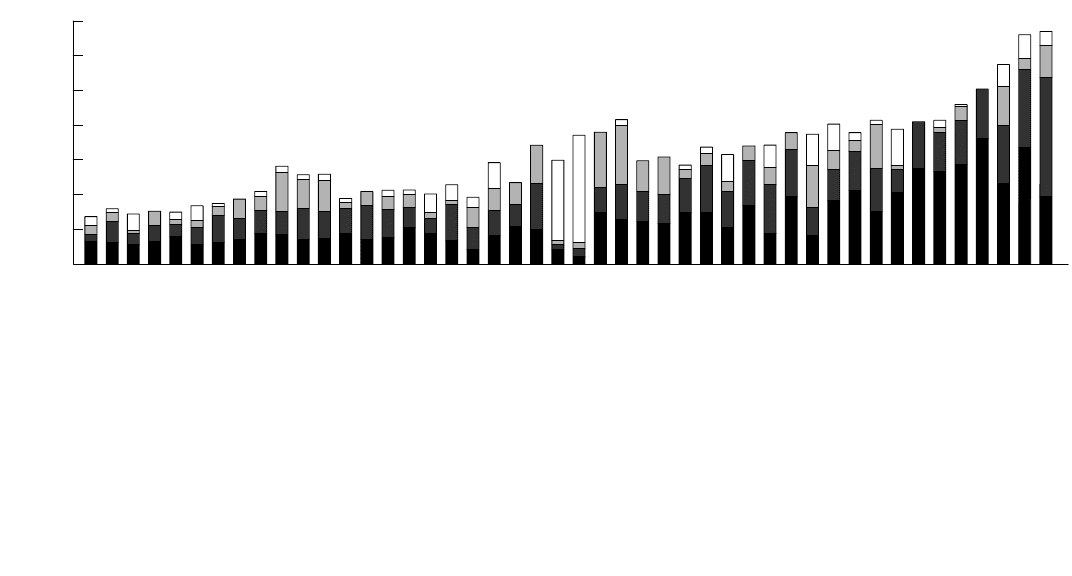Daunton M. The Cambridge Urban History of Britain, Volume 3: 1840-1950
Подождите немного. Документ загружается.


sociable entertaining pastime’ after the First World War, with over , amateur
groups in Britain by the s (by no means all middle class). However, the most
distinctive innovations in middle-class leisure were sporting, especially tennis and
golf. Before the s cricket was the most sophisticated suburban sport, pro-
viding young commercial and professional men with pleasant summer exercise,
and, by association, affirming gentlemanly aspirations. There was little for
women but croquet until young suburbans took up the newly invented lawn
tennis in the s. It spread rapidly through the medium of the club: one was
founded in the very first year of Bedford Park garden suburb, Ealing, in ,
and Nottingham’s exclusive Park estate had virtually no social facilities but tennis
courts. Badminton and table tennis also became popular, but lawn tennis took
the palm, with affiliated clubs multiplying tenfold by . Tennis appealed to
the energetic young; their marriage-broking, status-conscious mothers valued
tennis pavilion teas and dances. Golf had some democratic credentials when
played on Scottish seaside links, but in club form was a very different phenom-
enon. Male suburbanites took to the game with alacrity – seeking moderate
exercise (especially in middle age) in an associational form which protected or
enhanced social status. Thus Glasgow had twenty private golf courses for busi-
ness types by , compared with two public courses. In England, there were
, courses by , some of them in small country towns and seaside resorts.
Stanmore, Middlesex, was typical of the suburban type in requiring two propos-
ers for new members, granting ‘Ladies’ and some ‘artisans’ inferior status, and
excluding Jews. In industrial towns like Blackburn, with no extensive middle-
class suburbs, the golf club (), served the whole town, kept exclusive by a
limit of seventy members and a guinea annual subscription. Golf and tennis
contributed to the liberalisation of the middle-class Sunday; nearly half England’s
courses were open by , and nearly all by the s (although Calvinist
Scotland and nonconformist Wales resisted far longer). Cycling, boating and
motoring also played their part.
60
Douglas A. Reid
60
Jackson, Middle Classes, pp. –, –, –, , ; J. L. Garvin, The Life of Joseph
Chamberlain, vols. (London, –), pp. –, –; Newspaper Cuttings, Birmingham
Drama, vols. (Birmingham Reference Library, –); A. L. Matthison, Ladies Long Loved
and Other Essays (London, ), pp. , –; Cannadine, Lords and Landlords, p. ; Murfin,
Lake Counties, pp. ‒; G. W. Bishop, ed., The Amateur Dramatic Year Book and Community
Theatre Handbook (London, ), vol. , pp. –; New Survey of London Life and Labour, ,
pp. –; Nicholl, English Drama, pp. –; cf. Jones, Workers at Play,pp.–, and Norman
Dennis, F. M. Henriques and C. Slaughter, Coal is Our Life (London, ), p. ; John
Lowerson, Sport and the English Middle Classes, – (Manchester, ), pp. , , –,
–, ; Fraser, ‘Developments in leisure’, p. ; Helen Walker, ‘Lawn tennis’, in Mason, ed.,
Sport in Britain, pp. ‒; Dixon and Muthesius, Victorian Architecture, p. ; K. C. Edwards,
‘The Park Estate, Nottingham’, in Simpson and Lloyd, Middle Class Housing in Britain, pp. –;
James Kenward, The Suburban Child (Cambridge, ), pp. –; Jackson, The Middle Classes,
pp. (plate ), ; Rubinstein, ‘Cycling in the s’, –, cf. –, ; Graves and Hodge,
The Long Week-End, p. ; John Lowerson, ‘Golf and the making of myths’, in Grant Jarvie and
Cambridge Histories Online © Cambridge University Press, 2008

London’s suburbs were the most enormous and socially differentiated, but
their very size and prosperity encouraged an impressive range of activities.
Moreover, leisure activities were integral to their interwar extension, as many
plots of land were reserved for tennis courts, and even golf courses were con-
structed, as developers’ inducements to house purchasers. Finally, however, as
they grew larger it became hard to say exactly when suburbs ceased to function
as suburbs and more as towns within the conurbation increasingly attracting
commercial leisure facilities: roller skating in the s, theatres and music halls
in the s, cinemas in the early s, palais de danse in the s, and ice-
skating in the thirties. Although the middle-classes included some of the most
serious critics of mass leisure, their young were among its enthusiastic
aficionados.
61
(vi)
We turn now from the indirect impact of religious sentiment on urban leisure to
the much-debated impact of industrial urbanism upon religious practice. An
early and significant religious response to the development of industrial popula-
tions may be seen in the voluntary Sunday Schools movement which com-
menced in Gloucester in and quickly spread to Manchester and other
northern and Midland industrial towns. The schools’ aims of teaching factory
children to read the Scriptures, and to withdraw them from the temptations of
the streets, were buttressed after by those ‘steam engines of the moral
world’, the religious day schools. The second major response – commencing
during the post-Napoleonic War unrest – was ‘Church extension’. Parliament
acted to remedy the discrepancies between population and Anglican places of
worship which were believed to facilitate the flourishing both of Methodism and
irreligious popular radicalism. For several decades after the pillars, spires,
towers and high-windowed gables of hundreds of new churches rose into sooty
town air, summoning their urban denizens to worship. A similar process
occurred in Scotland. Thirdly, and concurrently, there was an attempt to apply
Playing and praying
Graham Walker, eds., Scottish Sport and the Making of the Nation: Ninety Minute Patriots? (Leicester,
), esp. pp. –; R. H. Trainor, ‘The elite’, in Fraser and Maver, eds., Glasgow, , p. ;
John Guest, The Best of Betjeman (Harmondsworth, ), pp. –; Lowerson, ‘Golf ’, pp. ,
–; Richard Holt, ‘Golf and the English suburb: class and gender in a London club,
c. –c. ’, Sports Historian, (), –; Beattie, Blackburn, pp. –, , ; Wigley,
Rise and Fall of the Victorian Sunday, p. ; Mandler, Rise and Fall of the Stately Home, pp. , ,
–, , .
61
Besant, London in the Nineteenth Century, pp. , , –; Bailey, Leisure and Class, p. ; Penny
Summerfield, ‘Patriotism and empire. Music-hall entertainment –’, in John M.
Mackenzie, ed., Imperialism and Popular Culture (Manchester, ), p. ; Richardson, The Social
Dances, p. ; Jackson, Middle Classes,pp.–, ; A. A. Jackson, Semi-Detached London
(London, ), pp. –, –; John Bale, Sport and Place: A Geography of Sport in England,
Scotland and Wales (London, ), pp. , ; Graves and Hodge, The Long Week-End,p..
Cambridge Histories Online © Cambridge University Press, 2008

in towns the essentially rural model of pastoral ministry. The most influential
theorist of this movement was the Presbyterian Church of Scotland minister, Dr
Thomas Chalmers. Whereas the church in the countryside buttressed the social
order – using patronage and charity to invoke deference – Chalmers observed in
‘every large manufacturing city ...amighty unfilled space between the high and
the low’. This, he avowed, should be filled with systematic ‘ties of kindliness’ –
district visiting by elders and Sunday School teachers – transferring some of the
evangelical energy for foreign missions to heathens in the city of Glasgow itself.
Essentially, Chalmers sought to recreate in the manufacturing towns the ‘moral
regimen’ which he felt characterised rural society (and, indeed, smaller provin-
cial towns). Impressed by Chalmers, the evangelical John Bird Sumner (–)
set on foot a programme of lay visitations, home instruction and further school-
ing in Chester diocese (incorporating rapidly urbanising Lancashire), to over-
come ‘the general state...oftotal apathy’and ‘religious destitution’. Conversely,
one of the best-known exemplars of a vigorous urban ministry on the rural
model was the high churchman, W. F. Hook, of Coventry (-) and Leeds
(–), promoting education, sick-dispensing, and self-help institutions,
preaching the Gospel, and supporting the Ten Hour movement.
62
The subdivision of huge parishes was a necessary, though insufficient, step in
Douglas A. Reid
62
A. P. Wadsworth, ‘The first Manchester Sunday schools’, in M. W. Flinn and T. C. Smout, eds.,
Essays in Social History (Oxford, ), pp. –, –; T. W. Laqueur, Religion and Respectability:
Sunday Schools and Working Class Culture – (New Haven, ); K. D. M. Snell, ‘The
Sunday School movement in England and Wales’, P&P, (), –, esp. ; John Hurt,
Education in Evolution: Church, State, Society and Popular Education – (London, ), ch.
; Michael Sanderson, Education, Economic Change and Society in England –, nd edn
(Basingstoke, ), pp. –, –; M. H. Port, Six Hundred New Churches: A Study of the
Church Building Commission, –, and its Church-Building Activities (London, ), pp. ,
‒; A. D. Gilbert, Religion and Society in Industrial England (London, ), p. ; Dixon and
Muthesius, Victorian Architecture, ch. ; Chris Brooks and Andrew Saint, eds., The Victorian Church:
Architecture and Society (Manchester, ), chs. , and ; Brown, Social History of Religion in
Scotland, pp. –, –; E. P. Hennock, ‘The Anglo-Catholics and church extension in
Victorian Brighton’, in M. J. Kitch, ed., Studies in Sussex Church History (London, ), pp.
–; David E. H. Mole, ‘The Victorian town parish: rural vision and urban mission’, in D.
Baker, ed., The Church in Town and Countryside (Oxford, ), pp. –; Inglis, Churches and
the Working Classes,pp.–; Gilbert, Religion and Society in Industrial England, p. ; T. Chalmers,
The Christian and Civic Economy of Large Towns (Glasgow, –), cited in B. I. Coleman, The Idea
of the City in Nineteenth-Century Britain (London, ), pp. , –; Stewart J. Brown, Thomas
Chalmers and the Godly Commonwealth in Scotland (Oxford, ), pp. –, esp. –; Boyd
Hilton, The Age of Atonement:The Influence of Evangelicalism on Social and Economic Thought,–
(Oxford, ), pp. –; H. D. Rack, ‘Domestic visitation: a chapter in early nineteenth
century evangelism’, JEcc.Hist., (), ; Robin Gill, The Myth of the Empty Church
(London, ), p. ; M. Smith, Religion in Industrial Society (Oxford, ), pp. , ‒ff.;
H. W. Dalton, ‘Walter Farquhar Hook, Vicar of Leeds: his work for the Church and the town,
‒’, Publications of the Thoresby Society.Miscellany, (), –; Sheridan Gilley, ‘Walter
Farquhar Hook, vicar of Leeds’, in Alastair Mason, ed., Religion in Leeds (Stroud, ), pp. –;
David E. H. Mole ‘Challenge to the Church. Birmingham, –’, in Dyos and Wolff, eds.,
The Victorian City, , pp. –, , .
Cambridge Histories Online © Cambridge University Press, 2008

this process of Anglican revitalisation. Thus evangelicals also initiated societies
of volunteer lay workers, such as the Religious Tract Society, or District
Provident Societies. In in Glasgow, and more generally from , extra-
parochial, inter-denominational City Missions were established systematically to
encourage Bible reading, and conversion. Thrift, providence, hygiene and self-
improvement were taught as necessary preconditions for living a Christian life.
The realisation of the depth of popular alienation in the s and s lent
urgency to this work, resulting in the employment of professional workers, and
attacks on pleasure fairs and Owenite ‘Infidels’.
63
The participation of nonconformists in City Missions illustrates the mitiga-
tion but not the elimination of the fierce rivalries between the establishment and
dissent. Some Congregationalists and Unitarians developed their own impres-
sive auxiliaries, doing the kind of mission and charity work which characterised
the Anglican parochial ideal, as at Carr’s Lane in Birmingham. They also
addressed the general education of their members through ‘mutual improvement
societies’, and, portentously, in the s the more rationalist denominations like
the Unitarians established explicitly recreational offshoots, planting seeds which
were to flourish dramatically in the second half of the century. The way had
been shown by the Sunday Schools through their Whit Walks, anniversary fes-
tivals and railway excursions (from the very inception of the Liverpool to
Manchester line in ). But it was in the s that chess, singing classes,
musical entertainments, tea parties, excursions, even dances, were developed for
adult members, to meet a desire for social fellowship and as a counterforce to
commercial entertainment, and to ‘moralise’ the working people it was hoped
to evangelise. A readiness to embrace recreation for religious purposes was
limited at this stage by the continuing influence of puritanism, but it was also
reflected in the foundation of Bands of Hope, providing rational recreation for
children as a prophylaxis against intemperance, and the YMCA, directed at the
salvation of young shopworkers. The specialised nature of both organisations
reflected the increasing complexity of urban society.
64
How effective were these decades’ work in dealing with religious ‘destitu-
tion’? The unique official census of religious attendance in offered little
Playing and praying
63
Lewis, Lighten their Darkness, pp. , –, , , –, –; E. R. Wickham, Church and
People in an Industrial City (London, ), p. ; Geoffrey Robson, ‘The failures of success:
working class evangelists in early Victorian Birmingham’, in D. Baker, ed., Religious Motivation
(Studies in Church History, , Oxford, ), pp. –; Brown, Social History of Religion in
Scotland, pp. , , –, ; Edward Royle, The Victorian Church in York (York, ), pp. ‒.
64
VCH, Warwickshire, ; W. B. Stephens, ed., The City of Birmingham (London, ), p. ; cf.
Cox, The English Churches in a Secular Society, pp. –; Reid, ‘Labour, leisure and politics’, pp.
–; Barry Haynes, Working Class Life in Victorian Leicester (Leicester, ); D. A. Reid,
‘Religion, recreation and the working class: Birmingham –’, Bulletin of the Society for the
Study of Labour History, (), ; Lilian L. Shiman, ‘The Band of Hope movement: respect-
able recreation for working-class children’, Victorian Studies, (), –; C. J. Binfield,
George Williams and the YMCA (London, ), chs. –.
Cambridge Histories Online © Cambridge University Press, 2008

encouragement. Depending on interpretation, it suggests that between and
per cent of the British population were in church on census Sunday. Today
this would be remarkable, but most agreed with census commissioner Horace
Mann that it signified an ‘alarming’and ‘sadly formidable’proportion of the pop-
ulation were ‘habitual neglecters’ of public worship. As the middle classes were
‘distinguished’ by their devotions, and the upper classes ranked regular church
attendance as ‘amongst the recognized proprieties of life’, most of the missing,
Mann opined, belonged to ‘the labouring myriads’ or ‘artizans’, who comprised
an ‘absolutely insignificant’ portion of the congregation, ‘especially in cities and
large towns’. What were the causes? ‘Social distinctions’, as manifested particu-
larly in pew rents, made it difficult to overcome the already profound gulf sep-
arating ‘the workman from his master’. Similarly, differences in social ‘station and
pursuits’ led to cynicism regarding the clergy. Even more profoundly, the ‘social
burdens’of ‘the poor’, particularly ‘the vice and filth which riot in their crowded
dwellings’, denied opportunities for religious reflection: ‘the masses of our
working population . . . the skilled and unskilled labourer alike . . . hosts of minor
shopkeepers and Sunday traders . . . and . . . miserable denizens of courts and
crowded alleys’ were ‘engrossed by the demands, the trials or the pleasures of the
passing hour, and ignorant or careless of a future’. However, although this led to
‘a genuine repugnance to religion itself ’, there remained ‘that vague sense of
some tremendous want, and aspirings after some indefinite advancement’ which
offered an opportunity to a more ‘aggressive’missionary activity by the churches.
Mann cited the ‘zeal and perseverance’ of Methodists and Mormons and street
preaching. Hence there were solutions which went beyond the obvious one of
removing pew rents. ‘Ragged Churches’ and mission halls could be built where
there would be ‘a total absence of all class distinctions’, lay preachers could be
used to confound suspicion of clergy motives, the religious contribution to
charity could be more overt and, above all, measures taken to improve housing.
All these would be more sensible than construction work, for, already, ‘teeming
populations often . . . surround[ed] half empty churches’.
65
How valid was Mann’s characterisation of the cities as black holes for the
churches? Post-war scholars were in no doubt. E. R. Wickham’s study of
Sheffield claimed that alienation of the urban working-class population from the
Douglas A. Reid
65
W. S. F. Pickering, ‘The census – a useless experiment?’, British Journal of Sociology, (),
, ; David M. Thompson, ‘The religious census of ’, in Richard Lawton, ed., The
Census and Social Structure: An Interpretative Guide to Nineteenth Century Censuses for England and
Wales (London, ), p. ; Michael R. Watts, ed., Religion in Victorian Nottinghamshire: The
Religious Census of , vols. (Nottingham, ), vol. , p. xiv; for the most recent guide to the
literature on see Clive D. Field, ‘The religious census of Great Britain: a bibliograph-
ical guide for local and regional historians’, The Local Historian, (), –; PP –
, Census , Religious Worship [England & Wales], pp. clviii–clxii. For recent ques-
tioning of the effectiveness of home missions see M. Hewitt, ‘The travails of domestic visiting:
Manchester, –’, HR, (), –, .
Cambridge Histories Online © Cambridge University Press, 2008

churches existed ‘from the time of their very emergence in the new towns’. The
‘index of attendance’ devised by K. S. Inglis stood at for small towns and rural
areas as compared with only for ‘large towns’, and Inglis followed Mann in
arguing that ‘the absent millions lived in large . . . industrial towns’.
Subsequently, Harold Perkin concluded that ‘the larger the town the smaller the
proportion of the population attending any place of worship; and . . . the larger
the town, with the exception of London, the smaller the proportion of Anglican
to all attenders’. Like Chalmers, Perkin related working-class indifference to the
decline of social dependency in towns, and he believed migrants drifted from
rural Anglicanism to nonconformity in small towns, and to indifference in cities.
This historiographical trend was reinforced by A. D. Gilbert’s work which
emphasised a deep link between urbanisation and ‘institutional secularisation’.
66
However, this consensus was challenged in the s, and much subsequent
work has followed a revisionist line, doubting whether the influence of urban-
isation on religion was so sweeping as had been assumed. Hugh McLeod util-
ised the and subsequent unofficial newspaper censuses from the s to
argue the primacy of regional and status-system distinctions over simple
rural/urban distinctions. Scepticism about urbanisation’s effects was stated most
trenchantly by Callum Brown in , who utilised regression analysis to suggest
that there was ‘no statistically significant relationship between churchgoing rate
and population size or growth for towns or cities’ in England and Wales in .
Nor, he argued, was population size of statistical significance for Scottish atten-
dance. Similarly, K. D. M. Snell’s investigation of the North Midland figures for
found only small, rather unconvincing, correlations between urbanisation,
industrialisation and low overall religious attendance.
67
Yet, in , Steve Bruce fundamentally questioned the statistical validity of
Brown’s case – explaining that the divergence of his regressions from Brown’s
was a consequence of the application of more reliable procedures and, particu-
larly, of Brown’s failure to allow for the distortion caused by the unique case of
London. Bruce argues that his results essentially reaffirm the message given by
the work of Wickham and Inglis. Thus, Brown’s statistical case must currently
be regarded as ‘not proven’. However, this critique of the statistical basis of
Playing and praying
66
Wickham, Church and People in an Industrial City,pp., –, –; Inglis, Churches and the
Working Classes, pp. –ff; Harold Perkin, The Origins of Modern English Society, –
(London, ), pp. , ; Gilbert, Religion and Society in Industrial England, pp. viii, ; see
also K. S. Inglis, ‘Patterns of religious worship in ’, JEcc.Hist., (), ; Pickering, ‘The
census – a useless experiment?’, –; Chadwick, The Victorian Church, , p. ; R. B.
Currie, A. D. Gilbert, and Lee Horsley, Churches and Church-Goers: Patterns of Church Growth in
the British Isles since (Oxford, ), pp. ff.
67
H. McLeod, ‘Class, community and region: the religious geography of nineteenth-century
England’ in M. Hill, ed., A Sociological Yearbook of Religion in Britain (London, ), pp. , –,
–, n. ; C. G. Brown, ‘Did urbanisation secularise Britain?’, UHY (), –; K. D. M.
Snell, Church and Chapel in the North Midlands (Leicester, ), pp. , –.
Cambridge Histories Online © Cambridge University Press, 2008

revisionism has yet to be widely appreciated. Partly, no doubt, this is because
work on regional sources has continued to show support for the revisionist case.
Thus Robin Gill used Episcopal Visitation Returns to show that churchgoing
in twelve large towns – including seven cotton factory towns – even grew during
-, the fastest period of urban growth. And Mark Smith’s study of the
classic industrialising district of Oldham and Saddleworth showed that the efforts
of a vigorous evangelical clergy bore fruit in an impressive per cent of the eli-
gible population attending church in .
68
All in all it is too sweeping to characterise cities and large towns as essentially
hostile to religion; regional and class analysis offers a more convincing explana-
tion of the relationship between urbanisation and churchgoing in Britain in the
nineteenth century. In , attendances were highest in England south of the
line from the Severn to the Wash, which were also the areas of greatest Anglican
strength, where squire and parson joined hand in hand to try to dominate the
mental, as well as the material, universe of the farm labourer. Within these areas,
with the important exception of London, towns and cities generally had higher
rates than the average for all cities: some were high-status cathedral cities, health
resorts and county towns like Bath, Gloucester and Hastings (with many inhab-
itants concerned about the ‘proprieties of life’) but they also included Plymouth
and Bristol. This once again suggests the importance of continuities between
country and city. Deriving initially from the high proportion of immigrants who
made up burgeoning urban populations, such continuities are also illustrated by
urban superstitions and rituals matching those found in the countryside, and
important to some popular religiosity in London even in the s. Conversely,
church attendance was generally weakest in the numerous industrial towns and
townships situated in the large upland parishes of the Midlands and North, and
lacking the social compulsions associated with southern landed estates. Thus the
towns of lowest attendance were low-status industrial towns such as Birming-
ham, the Potteries and Sheffield; and most towns in Lancashire, the West Riding
and the mining towns of the North-East were well below their regional aver-
ages. Nevertheless, some, like the Black Country towns and the Welsh industrial
towns of Wrexham and Llanelli stood well above them – local factors, such as
evangelistic blitzes on the exploited workforces of the Black Country, could
affect regional patterns.
69
Douglas A. Reid
68
Steve Bruce, ‘Pluralism and religious vitality’, in S. Bruce, ed., Religion and Modernisation (Oxford,
), pp. –; Gill, The Myth of the Empty Church,pp., –, , ; Smith, Religion in
Industrial Society, pp. ‒, .
69
McLeod, ‘Class, community and region’, pp. –; cf. John D. Gay, The Geography of Religion in
England (London, ), pp. –; Paul S. Ell and T. R. Slater, ‘The religious census of : a
computer-mapped survey of the Church of England’, Journal of Historical Geography, (),
–; C. G. Brown, ‘The mechanism of religious growth in urban societies. British cities since
the eighteenth century’, in H. McLeod, ed., European Religion in the Age of Great Cities (London,
), pp. –; Sarah Williams, ‘Urban popular religion and the rites of passage’, in McLeod,
Cambridge Histories Online © Cambridge University Press, 2008

Nonconformity had been the most popular religious tradition in towns in
, and was even more so by the s, when nearly six in ten attenders were
chapelgoers; only Bath and Hastings had more than half of their congregations
in Anglican churches. Nevertheless, the Church of England remained the largest
single denomination in most other towns and cities, reflecting its historical
centrality. The major nonconformist groups (Wesleyan Methodists, Baptists
and Congregationalists) outstripped the Anglicans in Leicester, Burnley and
Bradford, but groups with humbler adherents, like the Primitive Methodists,
were relatively weak in urban areas, except in Hull (the missionary headquarters
of its joint-founder, William Clowes), and Scarborough (its outpost up the
coast). Roman Catholicism was strongest in Liverpool (where it was the largest
denomination) and in other areas in the West Midlands and North-West most
subject to Irish immigration like Warrington, the Potteries and Barrow-in-
Furness.
70
If there was no simple relationship between religious attendance and the size
of towns, marked contrasts within urban areas firmly support the notion of a clear
relationship between religion and class. Towns were not undifferentiated wholes.
Hence, as McLeod pointed out, in the s’ newspaper censuses low-status dis-
tricts within cities had much lower church attendances than their high-status
counterparts. Thus, elegant Edgbaston and insalubrious Saltley were very
different within the overall ‘Anglican’ city of Birmingham, which had very low
attendance rates (like the region of which it was part). Classy Clifton and ‘poor
and populous’ St Philip and St Jacob, had contrasting, though high, rates, like
their city, Bristol, and its region (compare numbers , , and on Figure
.). For similar reasons there were also important correspondences as regards
denominational allegiances between high- and low-status areas of different
towns. As Figure . suggests, attendance in high-status districts, wherever they
were, tended disproportionally towards the established church (above all, in the
examples given, in Birmingham’s Moseley district, and in Hampstead), and
towards the major nonconformist churches (in East Leicester particularly). By
contrast, in low-status (working-class) areas Anglicanism was noticeably less
Playing and praying
ed., European Religion,pp., –; Sarah C. Williams, Religious Belief and Popular Culture in
Southwark, c. – (Oxford, ); Geoffrey Robson, ‘Between town and countryside:
contrasting patterns of church-going in the early Victorian Black Country’, in Baker, ed., The
Church in Town and Countryside, pp. –.
70
Inglis, ‘Patterns of religious worship in ’, ‒; McLeod, ‘Class, community and region’, pp.
‒; Gill, The Myth of the Empty Church, p. ; Hugh McLeod, Religion and Society in England
– (London, ), p. ; Gilbert, Religion and Society in Industrial England, pp. –; H. B.
Kendall, The Origin and History of the Primitive Methodist Church (London, ), vol. , pp.
–, , pp. –, –, –; Stubley, A House Divided, pp. –, ; Clive Field, ‘The
social structure of English Methodism, eighteenth-twentieth-centuries’, British Journal of Sociology,
(), ‒; David Hempton, The Religion of the People (London, ), p. ; McLeod,
‘New perspectives on Victorian working-class religion’, –.
Cambridge Histories Online © Cambridge University Press, 2008

B’ham: St Bart., St Mary, St Stephen 1
B’ham: Duddesdon, Nechells, Saltley 2
Sheffield North 3
Sheffield: Park 4
London: St George’s in the East 5
London: Shoreditch 6
Bradford: North, South & Bradford Moor 7
Bradford: East & West Bowling 8
Nottingham: North-East 9
Leicester: North & Middle St Margaret’s 10
Sheffield: Brightside 11
Sheffield: Attercliffe 12
B’ham: Aston Manor 13
B’ham: Bordesley & Balsall Heath 14
London: Poplar 15
London: Battersea 16
Liverpool: West Derby 17
Liverpool: Kirkdale 18
The Potteries: Hanley 19
The Potteries: Longton 20
Portsmouth: Kingston 21
Nottingham: Basford & Bulwell 22
Liverpool: Scotland 23
Liverpool: Exchange & Vauxhall 24
Bristol: Bedminster 25
Bristol: St Philip & Jacob 26
Sheffield: Eccleshall 27
Sheffield: Nether Hallam 28
London: Lambeth 29
London: Hackney 30
Liverpool: Toxteth 31
B’ham: Handsworth 32
Bradford: Little & Gt Horton 33
Bradford: Manningham 34
The Potteries: Burslem 35
The Potteries: Stoke 36
Portsmouth: Gosport 37
Nottingham: North-West 38
B‘ham: Edgbaston & Harbome 39
B‘ham: Moseley & King’s Heath 40
London: Hampstead 41
London: Lewisham 42
Portsmouth: Southsea 43
Liverpool: Abercromby 44
Bristol: Clifton & Westbury 45
Leicester East St Mary & East St Margaret 46
70
60
50
40
30
20
10
0
Percentages
Figure . Urban religious differentiation: attendance rates in selected areas
–⫽ low-status areas
–⫽ mainly working-class areas
–⫽socially mixed areas
–⫽ high-status areas
Source: drawn from data in H. McLeod, ‘Class, community and region; the religious geography of nineteenth-
century England’, in M. Hill, ed., A Sociological Yearbook of Religion in Britain (London, ), pp. –.
Cambridge Histories Online © Cambridge University Press, 2008

popular, and minor nonconformity was correspondingly stronger. Thus, major
differences within urban areas certainly vindicate Mann with regards to the
importance of class, and such findings are borne out by other detailed local
studies of different parts of London. However, it is worth noticing that the
strength of Roman Catholicism also implies the importance of religion as a
symbol of national or sectarian rather than class identity – a factor which may
also help to explain some of the social reach of Protestantism in Lancashire, and
the vitality of separate Protestant and Catholic Whit Walks.
71
(vii)
If class was the main factor conditioning non-churchgoing, how effective were
the proposed solutions? Pew rents were both the immediate cause and symptom
of the deeper social distinctions, argued Mann. There was much to this analy-
sis, particularly in relation to the poorest, but the problem was not straightfor-
ward. Some form of income generation was an economic necessity (especially
for the non-established churches lacking endowments), and pew rents were hal-
lowed by time, and legitimate within the framework of an unequal society of
ranks. Thus in Oldham and Saddleworth rents could be very low (a farthing per
quarter in Saddleworth before ), were sometimes not rigidly enforced, and
those who rented the cheaper pews felt that they were establishing their place in
the parish. From this perspective it was not so shocking that per cent of seats
in English churches in were pew rented. However, rents were heavily crit-
icised from the s, by both evangelicals and Tractarians, as an ‘intrusion of
human pride’ into God’s House, and a reform campaign resulted, with early suc-
cesses in Chesterfield, Pimlico and Clerkenwell. These criticisms represented a
realisation – hastened by Chartist demonstrations early in the decade – that many
had come to resent deeply such overt markers of their inferiority. The effect of
class society was exemplified graphically by the case of the Glasgow ‘city
churches’ of the Church of Scotland where pew-renting arrangements moved
from being socially inclusive to exclusive in the first decades of the century.
Middle-class demand pushed up the average rent to half-a-guinea for six months
by – – a trend reinforced by greater middle-class sensitivity to personal
hygiene – and cheap seats were abandoned. It is easy to see how pew renting
could alienate, though there was self- as well as enforced exclusion. Thus, even
where new free seats were provided in other Glasgow churches poor parishion-
ers rejected them – especially those who had known better times, and who
Playing and praying
71
McLeod, ‘Class, community and region’, pp. ‒; The Churchgoer, Being a Series of Sunday Visits
to the Various Churches of Bristol (Bristol, edn), pp. –; cf. Thompson, ‘The religious census
of ’, pp. –; Cox, The English Churches in a Secular Society, pp. –; Joyce, Work, Society
and Politics, pp. –; Neville Kirk, The Growth of Working Class Reformism in Mid-Victorian
England (London, ), ch. .
Cambridge Histories Online © Cambridge University Press, 2008
